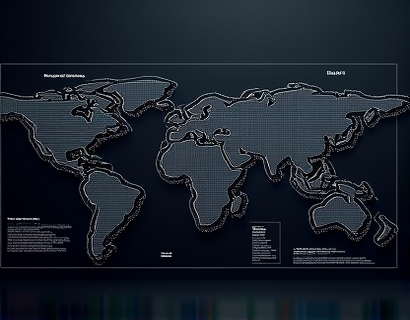Maximizing Multi-Chain Token Management: A Complete Guide for Blockchain Optimization and Performance
In the rapidly evolving world of blockchain technology, managing tokens across multiple chains effectively is crucial for maximizing performance and ensuring seamless operations. This guide provides an in-depth look at the strategies and tools necessary for optimizing multi-chain token management, tailored for blockchain professionals and token managers. By understanding the complexities involved, users can enhance their token's efficiency and value in the dynamic crypto landscape.
Understanding Multi-Chain Token Management
Multi-chain token management involves the creation, tracking, and optimization of tokens that operate across different blockchain networks. Each blockchain has its unique characteristics, consensus mechanisms, and smart contract capabilities, which can significantly impact token performance. For instance, Ethereum's EVM (Ethereum Virtual Machine) supports complex smart contracts, while Binance Smart Chain offers faster transaction speeds and lower fees. Understanding these differences is essential for tailoring token functionalities to leverage the strengths of each chain.
Key Considerations for Token Creation
When creating a multi-chain token, several factors must be considered to ensure optimal performance. First, choose the right blockchain for the token's primary use case. For decentralized applications (dApps) requiring complex logic, Ethereum or Solana might be suitable due to their robust smart contract ecosystems. For faster transactions and lower costs, consider Binance Smart Chain or Polygon. Additionally, consider the token's utility, such as governance, staking, or utility-based models, and design the token's economics accordingly.
Another critical aspect is interoperability. Ensuring that the token can seamlessly move between different blockchains enhances its utility and accessibility. Standards like Cosmos' Inter-Blockchain Communication (IBC) or Polkadot's XCM (Cross-Message Channel) protocol facilitate cross-chain interactions, allowing tokens to be used across multiple networks without the need for bridges, which can introduce delays and security risks.
Token Standard Selection
The choice of token standard is pivotal in determining the token's functionality and compatibility. Ethereum's ERC-20 is widely adopted for its simplicity and extensive ecosystem support. However, for more advanced features, consider ERC-721 (for NFTs) or ERC-1155, which supports both fungible and non-fungible tokens in a single contract. For cross-chain compatibility, standards like Wrapped Bitcoin (WBTC) or Binance Smart Chain's BEP-20 can be utilized.
When selecting a token standard, evaluate the trade-offs between flexibility, interoperability, and community support. A well-chosen standard can significantly reduce development time and costs while ensuring broader adoption and usability.
Smart Contract Optimization
Smart contracts are the backbone of token operations on most blockchains. Optimizing these contracts is crucial for enhancing performance and reducing costs. Here are some strategies to optimize smart contracts:
- Minimize gas usage by simplifying code logic and reducing the number of operations. Use efficient data structures and algorithms to lower computational overhead.
- Leverage layer 2 solutions such as Optimistic Rollups or ZK-Rollups to offload transactions from the main chain, reducing gas fees and increasing transaction throughput.
- Implement caching mechanisms to store frequently accessed data, reducing the need for repeated computations and database calls.
- Use modular design to separate critical and non-critical functions, allowing for selective re-deployment and updates without affecting the entire contract.
Regular audits and testing are also essential to identify and fix vulnerabilities, ensuring the contract's security and reliability.
Cross-Chain Bridges and Atomics
Cross-chain bridges enable tokens to move between different blockchains, but they come with their own set of challenges. Atomics, or atomic swaps, provide a trustless way to exchange tokens without intermediaries. However, ensuring the atomicity of these transactions across multiple chains is complex.
To enhance cross-chain token management, consider using established bridge protocols like Wrapped Bitcoin (WBTC) or the Polygon Bridge. These solutions have been thoroughly tested and offer reliable cross-chain transfers. Additionally, implementing custom atomic swap mechanisms can provide more control and flexibility, though this requires advanced development skills and thorough testing.
Monitoring and Analytics
Effective monitoring and analytics are vital for understanding token performance and making data-driven decisions. Utilize blockchain explorers and analytics tools to track token transactions, ownership, and market trends. Tools like Blockscout, Glassnode, or Chainalysis offer comprehensive insights into token activity across multiple chains.
Set up custom dashboards to visualize key metrics such as token supply, distribution, and transaction volume. This data can help identify potential issues, optimize distribution strategies, and enhance user engagement. Integrating real-time data feeds ensures that insights are always up-to-date, allowing for timely adjustments to token management strategies.
User Experience and Accessibility
Enhancing the user experience is crucial for the adoption and success of multi-chain tokens. Ensure that the token's interfaces, whether on decentralized applications or wallet integrations, are user-friendly and intuitive. Provide clear documentation and support resources to help users understand and utilize the token effectively.
Consider developing multi-chain wallets that support seamless token management across different networks. Wallets like MetaMask or Trust Wallet offer cross-chain capabilities, but custom solutions can provide a more tailored experience. Ensure that the wallet supports multiple token standards and integrates with various blockchain networks to enhance usability.
Compliance and Regulatory Considerations
Navigating the regulatory landscape is a critical aspect of token management. Different blockchains and jurisdictions have varying regulations regarding cryptocurrency and token offerings. Stay informed about local and international laws to ensure compliance and avoid legal issues.
Engage with legal experts who specialize in blockchain and cryptocurrency to navigate complex regulatory requirements. Implement know-your-customer (KYC) and anti-money laundering (AML) protocols to maintain transparency and security. Compliance not only protects the project but also builds trust with users and stakeholders.
Community Engagement and Governance
Building a strong community around the token can significantly enhance its value and adoption. Implement governance mechanisms that allow token holders to participate in decision-making processes. Platforms like Aragon or MakerDAO provide frameworks for decentralized governance, enabling transparent and secure voting systems.
Foster community engagement through regular updates, transparent communication, and active participation in relevant forums and social media channels. Host AMAs (Ask Me Anything) sessions with the development team and organize community events to build a loyal and supportive user base.
Future-Proofing and Scalability
As the blockchain ecosystem continues to evolve, future-proofing the token is essential for long-term success. Stay abreast of emerging technologies and trends, such as layer 2 solutions, interoperability protocols, and new token standards. Incorporate these advancements into the token's design to ensure scalability and adaptability.
Plan for potential upgrades and updates, designing the token's architecture to support modular enhancements. This approach allows for incremental improvements without disrupting existing functionality. Regularly assess the token's performance and user feedback to identify areas for enhancement.
Conclusion
Maximizing multi-chain token management requires a comprehensive approach that addresses creation, optimization, monitoring, and community engagement. By understanding the unique characteristics of different blockchains, selecting the right token standards, optimizing smart contracts, and leveraging cross-chain solutions, token managers can enhance performance and value. Emphasizing user experience, compliance, and community involvement further solidifies the token's position in the dynamic crypto landscape. With these strategies in place, blockchain professionals and token managers can navigate the complexities of multi-chain token management with confidence and precision.










































